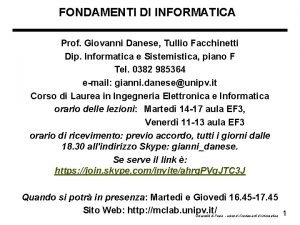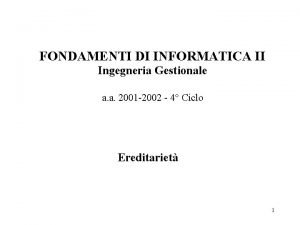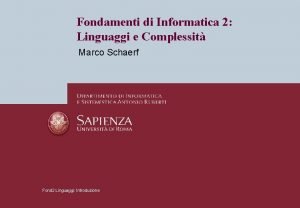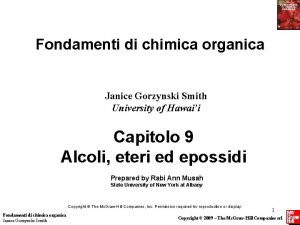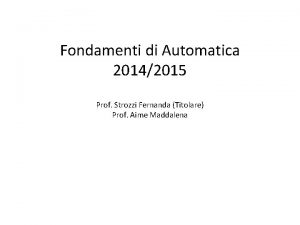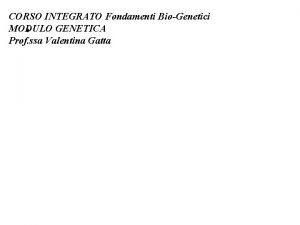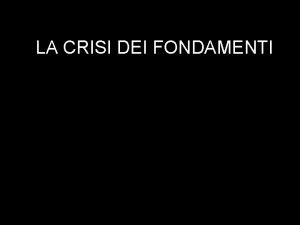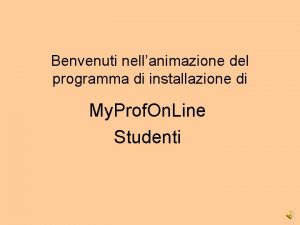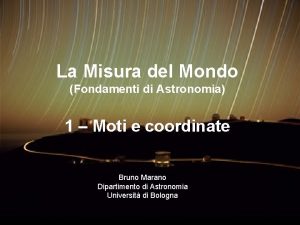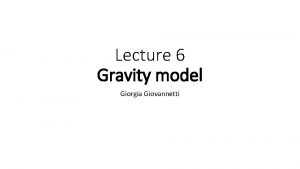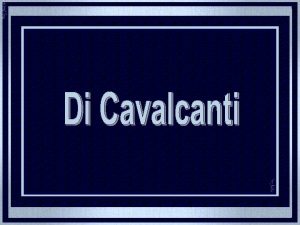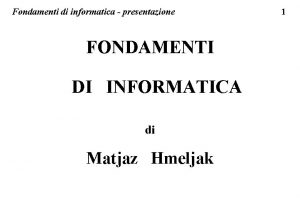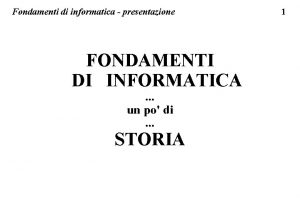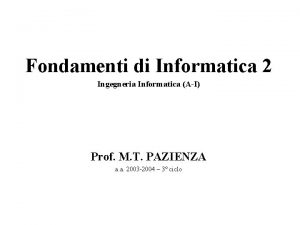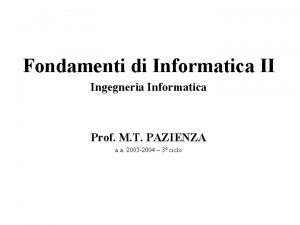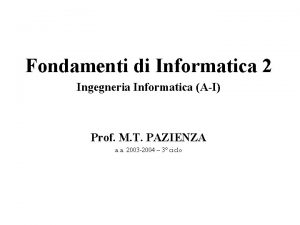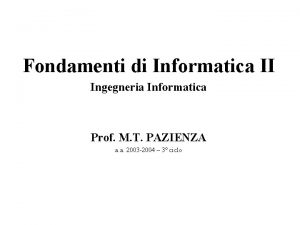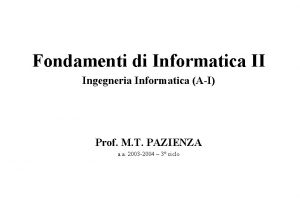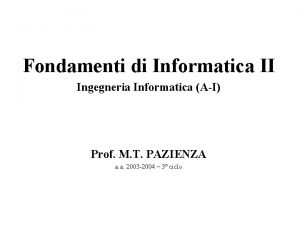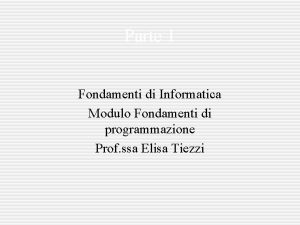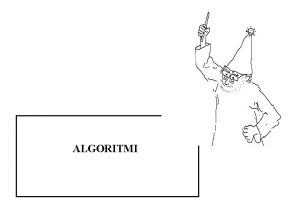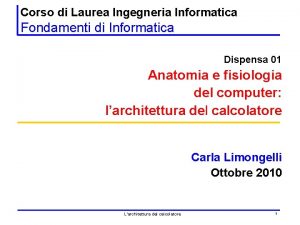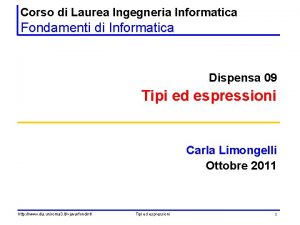Fondamenti di Informatica Recursion Prof Emiliano Casalicchio emiliano
















- Slides: 16

Fondamenti di Informatica Recursion Prof. Emiliano Casalicchio emiliano. casalicchio@uniroma 2. it

Concept: Basic Stack Operations The Activation Stack is a stack used by the operating system to manage the execution of function calls 1 -2

Concept: The Activation Stack n When the user starts a program, the operating system allocates enough memory to load the application and a block of memory to contain its activation stack. n When that application calls a function, the parameters and local variables occupy a stack frame that is pushed onto the activation stack. n The calling program is then suspended and control is passed to the function specified in the new frame. n When that function completes, its frame is destroyed; any returned data and control is returned to the frame beneath. n Note that in a MATLAB implementation, the stack frame is the storage environment for the current workspace. 1 -3

Function Specification vs Function Instances n The file defining the function merely specifies how it would behave if you ever called it. This is the function specification. n When you call the function, a stack frame is created, parameter values are supplied and you have a fully defined instance of that function. n There is no reason in principle why a function cannot “call itself, ” because each call is a different instance of the function. 1 -4

9. 2 Recursion Defined For a recursive program to succeed, it must satisfy three basic requirements: n There must be a terminating condition specifying when to stop the recursion n The function must call a clone of itself (with different parameters) n The parameter change must move the data towards the terminating condition 1 -5

Implementing a Recursive Function in MATLAB The MATLAB template for recursion is: function <result> = <function_name> (<formal_params>) % <documentation> if <terminating condition 1> <result> = <initial value 1> elseif <terminating condition 2> <result> = <initial value 2>. . . else <result> = <operation>. . . (<formal_params>, . . . <function_name> (<new_params>) ) end 1 -6

Factorial n n!=n*(n-1)!, 0!=1 (by def) n 3!=3*2*1!=3*2*1*0!=3*2*1*1=6 function result = fact(N) % recursive computation of N! % fprintf('fact( %d )n', N); % testing only if N == 0 result = 1; else result = N * fact(N - 1); end 7

fact(3) n N=3, fact(3), result = 6 n N=2, fact(2) , result = 2 n N=1, fact(1), result = 1 n N=0, fact(0), result = 1 8

The Fibonacci Series n Leonardo Pisano Fibonacci, studied rabbit populations n Starting with a pair of newborn rabbits, he wanted to calculate the rabbit population after a year. fib(n) = fib(n-1) + fib(n-2) n This is, of course, recursive where fib(1) and fib(2) are both 1. n Computationally, this turns out to be very unpleasant n Results in the series: n 1, 1, 2, 3, 5, 8, 13, 21, 34, 55, 89, 144, 233, …, n This series occurs frequently in nature 1 -9

Fibonacci Rabbits 1 -10

Fibonacci in Nature 1 -11

fib(5) n N=5, fib(5)=fib(4)+fib(3), n N=4, fib(4)=fib(3)+fib(2), n N=3, fib(3)=fib(2)+fib(1), n N=2, fib(2)=1 n N=1, fib(1)=1 n N=3, result=2 n N=2, fib(2)=1 n N=4 result=3 n N=3. . n N=5 result=5

Palindromes n alla n onorarono n Ingegni n radar n anna n otto n parlo col rap n i topi non avevano nipoti 13

Palindromes function ans = is. Pal(str) % recursive palindrome detector if length(str) < 2 ans = true; elseif str(1) ~= str(end) ans = false; else ans = is. Pal(str(2: end-1)); end 14

A Zero Crossing Problem n Given an unknown function y = f(x), 1 -15

A Zero Crossing Problem 1 -16
 Giovanni danese unipv
Giovanni danese unipv Fondamenti di informatica 2
Fondamenti di informatica 2 Marco schaerf
Marco schaerf To understand recursion you must understand recursion
To understand recursion you must understand recursion Chimica organica
Chimica organica Teleonomica pedagogia
Teleonomica pedagogia Giddens fondamenti di sociologia
Giddens fondamenti di sociologia Componenti principali di un computer
Componenti principali di un computer Il naturalismo francese i fondamenti teorici
Il naturalismo francese i fondamenti teorici Impedenzimetro
Impedenzimetro Fondamenti di automatica unife
Fondamenti di automatica unife Genotipo
Genotipo Gli angoli retti
Gli angoli retti Fondamenti di automatica benvenuti
Fondamenti di automatica benvenuti Fondamenti di astronomia
Fondamenti di astronomia Emiliano giovannetti
Emiliano giovannetti Mulheres com frutas (1932)
Mulheres com frutas (1932)
